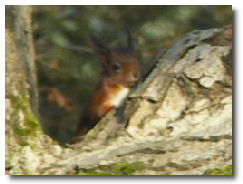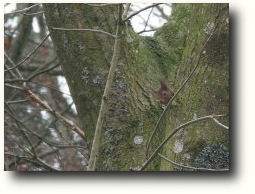Wight Conservation - Red Squirrel
 The Red Squirrel is to be found in all Wight Conservation’s woodlands. Abundance varies, but since it is shy and seldom seen on woodland walks, no records are kept. Populations fluctuate, depending upon the harshness of the winter and the food availability in the spring. The Red Squirrel is to be found in all Wight Conservation’s woodlands. Abundance varies, but since it is shy and seldom seen on woodland walks, no records are kept. Populations fluctuate, depending upon the harshness of the winter and the food availability in the spring.
The Isle of Wight is particularly important for the species. Although common on the Continent, in the UK it is a threatened and declining species. Once widespread, it is now unable to compete with the Grey Squirrel and it has a low resistance to disease.
The largest numbers are to be found in Scotland and the north of England, although there are smaller populations in East Anglia and Wales, plus some on Brownsea Island in Poole Harbour
The IW is considered to be potentially the last outpost for the squirrel’s survival as its population continues to decrease on mainland Britain.
The IW is unusual because the squirrel has been traditionally reliant upon the broadleaf woodlands, although conifer now forms an important habitat because it offers an almost year round food supply from its cones.
Diet varies with the availability of food throughout the seasons. Food is shortest in the spring; the over-winter stock piles of nuts have been exhausted, and the re-emergence of the strong vegetative growth in the summer is still awaited. Pine seeds, bark, buds and fresh shoots, catkins and wildflower grazing provide the bulk of its intake.
In summer, the diet extends to ash and field maple keys, fruits, leaves, and shoots of trees and shrubs.
Autumn is store time, and in addition to eating hazel, sweet chestnut, acorns and beech nuts, a good supply is put by for the approaching winter.
The squirrel’s body fat will have increased during the summer and autumn to enable it to withstand the winter. Its nut stores will be fully utilized and, when short, the squirrel will resort to feeding upon pine seeds, bark, and barbs etc.
 Management of our woodland habitat to favour the red squirrel is important to Wight Conservation. Ride widening and management, together with the thinning of trees and glade creation, serve to let more light onto the forest floor, and hence encourage the growth of food sources. The openness of the rides and glades, not only increase the woodland edge available, but also permits the squirrel to forage in less danger from predators. Management of our woodland habitat to favour the red squirrel is important to Wight Conservation. Ride widening and management, together with the thinning of trees and glade creation, serve to let more light onto the forest floor, and hence encourage the growth of food sources. The openness of the rides and glades, not only increase the woodland edge available, but also permits the squirrel to forage in less danger from predators.
Hazel is regularly coppiced, on a chequer board basis with a 15-18 year rotation. The stools start bearing fruit about three years after coppicing and, with the additional sun light, are more likely to provide good nut crops until eventually they become shaded out. The process then begins again after re-coppicing.
Although our woods are predominantly broadleaved, clumps of conifer are still kept and will be replanted to provide an over-wintering supply of pine seeds.
When thinning, i.e. periodical removal of the poorer and deformed trees to allow more room for the better to mature, care is taken not to fell any conifers where there is evidence of squirrel feeding. A proportion of sweet chestnuts are kept because the squirrel finds their nuts a particularly succulent form of food.
When thinning or felling, care is taken so that no trees with squirrel drays are cut down. Care is also taken that sufficient over head walkways in the canopy exist for the squirrel to move around freely.
|